|
||
|
||
|
8 Srpen 2019, 1:16 AM
Today, 5 August 2019 has become a historic day in our history as something which could not be done in 70 years has taken shape now. Union Home minister Amit Shah has announced that Article 370 which grants special status to the state of Jammu and Kashmir will be scrapped. He also announced that Jammu and Kashmir will no longer be a state and it will be bifurcated into two Union Territories— Jammu & Kashmir and Ladakh. Číst více...

19 Září 2019, 3:18 AM
Is ours an ideal democracy!! Hardly so, it is far from being an ideal democracy; where there should be two equal opponents, like Conservative and Labour party in Britain; like Republican and Democratic party in USA. As for India, for the two major parties here i.e. Congress and BJP there has never been a state of relative equilibrium. There was a time when Congress was all powerful for a long time, BJP had not come into existence then. BJP came into existence and gradually spread its wings and the status now of present election result on 23 May 2019 is that BJP alone bagged 303 seats and 353 seats along with its NDA Alliance. Congress on the other hand could muster only 52 seats; along with UPA, Congress got 91. Other parties won 98 seats. What to talk of equality, Congress party could not win even 55 seats which is the requisite 10 % to become the official opposition. Číst více...

8 Červenec 2020, 5:27 PM
Our is primarily an agricultural country and major part of our economy is dependent on agriculture. To have a timely and adequate crop, rains are but a necessity. Eminent role of rains has been stressed in our classics as rains are a must for producing our food. No one can thrive without food. Be it material or spiritual gains, nothing is possible till we have fed our bodies with enough food. Great scholar and astrologer Varahmihira writes in Brhat Samhita:
“Annam jagatah pranah
Pravatkaalasya ch annam-aayatamm |
Yasmadatah preekshya
Pravatkaalah prayatnen ||”
Meaning: Anna (food grains) gives life to all beings. Without rain, it is difficult to have crops, so it is important that astrologers study rain carefully.
Scientists today use only science and terrestrial phenomenon to study rains whereas astrologers use extra-terrestrial phenomenon considering all the planets, not merely Sun and Moon, to get the results and correctly so.
Brilliant rishi astrologers can aptly predict good rain and drought through various charts and use of some chakras. Esteemed Guruji Shri K.N. Rao Sir predicted delayed monsoon in 1987 even when Rajiv Gandhi government had declared it a drought year. In a letter to newspaper ‘Statesman’, he predicted that the spell of drought would be broken and it happened exactly as predicted, correct to the dates given. He was popularly known as ‘The Weather Prophet’ then.
Many farmers, poor and middle-class are solely dependent on rains for their crops. If only they could know that the seeds they sow would be well-watered by rains in subsequent months, it could be a big help. In 1987, farmers did sow seeds in June and again in July but the delayed monsoon was a big disappointment, their seeds were wasted.
Dr. K. L. Rao proposed inter-linking of rivers in 1972, he suggested that flooded river basins be linked with water deficit river basins, using a network of canals. Thereby, Dastur suggested the ‘Garland scheme of rivers’ which means that all rivers should be connected. Garlanding the rivers could be a big progressive step for our nation. Today 90% of our water is flowing back in the oceans. We must look upto Israel to see how they have tackled their water problem. A scheme initiated in 1972 must be taken forward by our people, to enhance our agriculture produce, for the betterment of our country, for the betterment, happiness and prosperity of our farmers.
Weather predictions can be done at four levels:
1) Long range predictions
2) Medium range predictions
3) Short range predictions
4) Instant predictions
Long range predictions are the ones which can be done many years in advance. In the 100 year ephemeris (Shatabdi Panchang) of Venkateshwara press published in 1944, it was written that monsoon season shall beget little rain in 1987. The ephemeris said “Sravan main aage chala Ravi rath se Kujray; Bhadhjav Krishna Pankhlo varsha swalpa dikhay.” this beautifully and brilliantly emphasizes that rain shall be scanty if Mars is ahead of Sun in the rainy season. This is only one example when we have loads of such hints available to us.
The long range predictions are dependent 100% on astrology. These are based on the horoscopes made for the year viz. Chaitra Shukla Pratipada chart, various paksh and sankranti charts and most important the Ardra Pravesh chart when Sun enters Ardra nakshatra in Mithun rashi.
When Sun is in Mrigshira, which is in end of May, South West monsoon strikes Kerala (Rohini Pravesh is used for rains in South of India); when Sun enters Ardra, monsoon moves towards the North of India. When Sun enters Kanya rashi, monsoon prepares to withdraw from northern India.
When Sun enters Hasta, it is time to rain in Bihar; this is popularly called ‘Hathiya’ rain. By this time rain withdraws from rest of North India. When Sun enters Chitra, it causes occasional rains, South West rains have also withdrawn by this time. Monsoon season is from Rahu nakshatra ‘Ardra’ to Rahu nakshatra ‘Swati’. Chatak bird is referred to in our classics which waits for the drop of rain in Swati.
Medium range predictions are made on the condition of clouds formed, direction of winds, lightning etc. 195 days before the monsoon. These factors are studied in the month of November and December each year. When Moon enters Poorva Asada in the month of Mrigshira (Pratipada of shukla paksh) the above mentioned omens are studied; this is garbhadharan of clouds (impregnation of clouds). The impregnated clouds will deliver rain when Moon enters same nakshatra 195 days later, which is in the month of June next year. The mechanism is so that the fetuses formed in the bright fortnight will be released in the dark fortnight and vice versa. Those formed at daytime, will be release in night and vice versa; formed at dawn, released in evening and vice versa, formed in East will pour in West and vice versa and formed in North, pour in South and vice versa.
Revered Shri K.N. Rao Sir has listed clearly in his articles the symptoms of healthy conception of clouds and otherwise. I am quoting some of those:
A pleasant cool breeze from North, East and North East; a clear sky; bright halo around Sun and Moon; Moon and stars shining brightly; auspicious twilight in morning or evening accompanied with rainbow; rumbling of thunder; pleasant cry of birds in the East or North East and not facing the Sun; trees with sprouts unimpaired, Men and animals happy; Sky covered with large bulky, smooth needle like or razor-like red, blue or green tinged clouds; these are the symptoms of healthy conception of clouds.
Fall of meteors; thunderbolt and lightening; Dust storms; False fire; Earthquakes; appearance of city like formation in the sky; Ketu; planetary fight (grah yuddha); unnatural phenomenon in rain like appearance of blood, a cross bar of clouds, a sunset or sunrise rainbow; eclipse etc.; these are the symptoms of miscarriage of fetus. If there is an affliction of many malefics during cloud formation, hailstorms and thunderbolt will be the result. Excessive rains at the time of cloud formation will destroy the fetus.
Similarly for winter rains, the garbhadhan has to be observed in uttarayana period (14 Jan to 16 July)
Short range predictions are done by studying the weather when Rohini Yoga, Swati Yoga and Asada yoga are formed. These are the yogas formed when Moon enters the aforesaid nakshatras i.e. Rohini, Swati and Uttar Asada in the lunar month of Asada which falls in the month of June-July.
This happens only once a year. If on these days, the sky is loaded with clouds, be it black, white or red; accompanied with lightning before sunrise or sunset.
If on the contrary, there is no rain on these days, ill-formed clouds in the shape of camels, crows, dead bodies, monkeys, it would be difficult to have rains.
If these days have thunderbolts, fall of meteors, lightning flashes or false fires, it is horrible for the monsoon.
It is actually very amazing how the study of these three yogas defines the monsoon season.
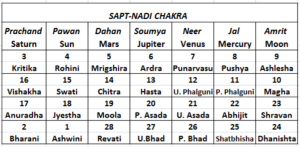
Sapt-Nadi Chakra is effectively used for short range predictions in Astro-Meteorology. During the monsoon i.e. when Sun transits in ten nakshatras from Ardra to Swati, the vedha of planets in this nadi chakra is effectively used to determine rain. As the name suggests, it has seven nadis. Starting with Kritika, planets are placed in a snake like fashion in the seven nadis. Abhijit nakshatra is also used in this chakra, 28 chakras are plotted in seven nadis. In the chakras used in this article, I have used numbers for nakshatras whereby 22nd nakshatra is Abhijit. Abhijit in Makar spans from 6 degrees 40 minutes to 10 degrees 53 minutes.
The seven nadis of Sapt-nadi chakra being:
1) Prachand (Fierce) ruled by Saturn showing excess heat
2) Pawan (Windy) ruled by Sun showing hot winds of summer
3) Dahan (Fiery) ruled by Mars showing heat
4) Soumya (Sober) ruled by Jupiter is the transition phase from hot to cooler winds
5) Neer (Rain) ruled by Venus showing first showers
6) Jal (Water) ruled by Mercury showing plenty of rain
7) Amrita (Nectar) ruled by Moon showing abundant rain
The nadis are also grouped as:
a) Yamya nadis - The first three nadis Prachand, Pawan, Dahan are also known as Yamya nadis. These are also known as Dakshin nadis. They account for heat and hot winds.
b) Soumya nadi - The nadi in the middle which is not hot, not cold
c) Sajal nadis - Neel, Jal, Amrit nadis come under this category. These are also known as Uttari nadis.
How Sapt-Nadi chakra works:
1) A planet placed in a nadi behaves according tothe behaviour of the nadi, in Prachand nadi storms, in Pawan nadi winds flow, in Dahan nadi very hot temperature indicated, in Saumya nadi moderate temperature, clouds form when planet is in Neer, in Jal rain occurs and in Amrit ample rain pours.
2) More planets in Sajal nadis with Moon show much rain
3) Moon, Mars, Jupiter in one nadi give muchrain
4) Mercury, Venus, Jupiter, Moon shall give rain
5) Malefic planets Sun, Saturn, Mars shall formclouds but are incapable of giving rain
6) If along with malefics, benefics are also therein the same nadi, moderate results to be expected.
7) When Moon comes in such a nadi, it rains.
8) Mars placed in which ever nadi, makes the nadivery active.
9) If a malefic and a benefic are placed in samenakshatra, and Moon joins in, it rains
10) If a malefic and a benefic are placed in samenakshatra and the degree of Moon comes close to the planets, rain is the result.
11) When Moon enters a nadi where already aplanet is placed, weather fluctuates.
12) When Moon joins 5 planets in Neer nadi, rainwill last for six days; in Jal nadi for 12 days; in Amrit nadi, rain for 24 days.
Instant predictions can be given by watching the behaviour of animals and birds during the monsoon season.
- Lizards getting down the wall, face upwardsindicate rain is about to come.
- If ants are moving up the wall with eggs in theirmouth, with their face downwards
- Cow looking up at the sky shows the rain is aboutto come.
- Pet dog pulling at the leash and refusing to goout of the house, rain expected in few hours.
- Peacocks dancing indicates rain.
- If spider weaves its web outdoors, it calls fordeparture of rain.
- If kites fly at the height of about 400 feet, it isindication of rain or storm.
- Frogs croaking indicates rain.
Poets Ghagh and Bhaddari have given some wonderful quotes with respect to rain, which are so true till date. It is the ancient astrological wisdom beautifully woven with the culture of the time. For example for frogs croaking it is written:
Barkha aawat dekh karbhai kokila maun;
Ab to dadur boli hain; hamen poochi hain kaun
Meaning: With the advent of monsoon, koel birds are quiet, they (koels) say that no one shall be listening to them now that the monsoon is coming, only frogs shall croak.
Poet Ghagh writes when Mars is ahead of Sun, it indicates less rain
“Mangal rath aage chale, peeche chale jo Sur,
Mand virshti tab jaaniye, padsi sagle shoor”
With regards to plants, there are there are some beautiful indications:
- If Gulmohar flowers bloom in Delhi, it shall rain. If Gulmohar doesn’t
bloom, no rain
- If neem tree flowers timely i.e. in Apr-May, there will be rain.
- In Himachal there are ‘Nagphana’ plants, if that dries in June, there will be no rain.
Some rules to analyse Ardra chart:
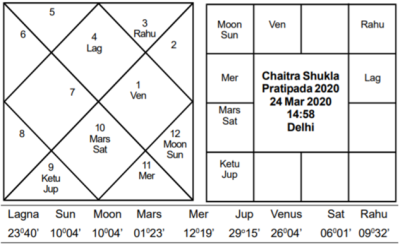
- Note the benefics and malefics inkendra, benefics encourage rain, malefics stop it.
- Check the lagna rashi, aspects on the same
- Check the placement of Moon and Venus andinfluences on the same.
- Mars ahead of Sun delays rain
-Sun between Venus and Mercury is a deterrent factor for rains. Venus phenomenon was studied in detail by senior research class of Bhartiya Vidya Bhavan in 2012 and was well-presented in seminar.
- Two benefics and two malefics in the samenakshatra, it rains, be it monsoon or no monsoon
- Taurus rashi and Venus affliction, especiallyRohini Shakat bhedan should be checked. If Rohini is afflicted, drought, famine, war can be the result.
- Retrograde Saturn is not good for rain and directJupiter is not good for rain (These are researches of revered Shri K. N. Rao Sir, researches from which the whole fraternity of astrologers keen on astrometeorology is benefitting)
- Mercury retrograde or direct, set or rising,changing signs or nakshatras, it is very important to watch for temperature fluctuation as Mercury is the catalyst.
- Any planet about to change sign influences rain,when major planet changes rashi, a perceptible change can be seen.
- Any planet retrograde or direct influences rain
- Any planet about to set or rise influences rain
- Mars and Jupiter close within 30 degrees are bad for rains
- When Moon joins Venus or is in trine with Venus, there is fluctuation in weathereicorn, Pisc
- Moon in Cancer, Capricorn, Pisces is good for rainmoon in 5,7,9 from Saturn is good for rain
- Jupiter ahead of Sun and Venus causes extreme cold - Conjunction of Sun and Saturn causes cold wave in North India
MONSOON 2020
Rains in our country are assessed through the study of winds and clouds on some specific days as per astrological calculations. The behaviour of flora and fauna has to be taken into account always. Then there are several horoscopes to be studied. The Chaitra Shukla Pratipada (Hindu New Year) chart is to be studied first of all. Next is the chart of Mithun Sankranti, where planet which is declared as Meghesh in the planetary cabinet gives us a fair idea of the rains for that season. Finally comes the Ardra Pravesh chart and consecutive charts studied in collaboration with chakras which give us a fair idea of rain in the monsoon season.
In Chaitra Shukla Pratipada 2020 chart, Karka lagna is rising, watery rashi aspected by two malefics from Makar rashi shows excess of water and trouble due to same as Saturn is aspecting lagna as the eighth lord. There is one benefic and two malefics in kendra. Venus in the sign of Mars, is the only benefic in kendra and that also is aspected by both Jupiter and Mars which gives it ferocity. These factors also account for the cyclones in India. Mercury is the King of the year, ill-placed in the eighth house in airy rashi Kumbha which has 50% water showing some winds and storms along with rain.
Varahmihira in his classical book Brhat Samhita gives results of various planets as lords of years. For Mercury as lord of year, it states:
“It will be a good year for people having profession in magic, mines, hypnotism and jugglery as well as for musicians, townsmen, mathematicians, painters, accountants and fighters. Rearing of cattle, agriculture, and trade will thrive. Justice will be administered by the King. Vedic studies will be pursued. Spiritualism and scientific studies will prevail. Envoys, children, eunuchs, perfumers and those who live near the bridges, water and mountains will be happy. Plantations and herbs will be in plenty.”
We can see that the results given can not be taken verbatim. These are the best of results. We have to see the whole chart, study the position, condition and strength of the planets to pronounce a judgement.
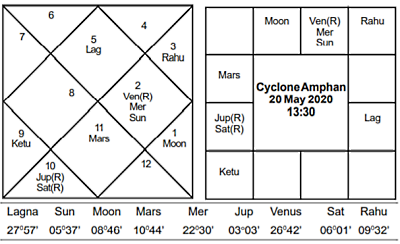
When we look at the Hindu New year chart, an indication of earthquakes and water calamity can be seen when we see the afflicted watery rashis and afflicted earthy rashis. On 20 May 2020, when cyclone Amphan finally fell between 10:00 and 11:00 UTC, look at the planetary position on Sapt-Nadi chakra. Venus and Rahu and Ketu were in Dahan nadi; ruled by Mars, whereby Mars was in Jal nadi. Moon was in the same nadi a day before. Mercury was in Rohini in Pawan nadi, about to change nakshatra and enter Dahan nadi when the cyclone fell off. Time when Mercury rises or sets, when Mercury changes nakshatra or changes sign, are to be marked for important changes in weather.
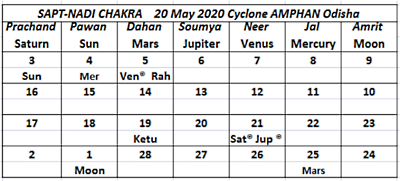
In fact when the cyclone started brewing up on 16th May 2020, Moon and Mars both were in Shatbhisha. It is worth noting that Venus got retrograde on 13 May 2020 and on 14 May 2020, Jupiter had gone retrograde.
Three major planets are placed in Sheetal nadis, two of them retrograde. With six planets in Yamya nadi, out of which three are benefics, a cyclone brew up
More horoscopes need to be studied for judging the monsoon season. Sankranti charts and Paksh charts should be studied. Day Lord of the horoscope made when Sun enters Mithun rashi especially tells us about the rain in store for us and is so named ‘Meghesh’.
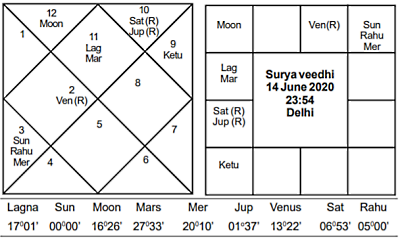
In the Mithun Pravesh of 2020, Sun is Meghesh; a dry planet conjunct with Rahu and retrograde Mercury in Mithun. Venus retrograde does not show rain but aspect of retrograde Jupiter is a promise of relief and aspect of Mars shows the intensity. Moon in watery rashi is always good for rain but here aspect of retrograde Saturn is a deterrent factor. In Sapt-nadi chakra Sun, Rahu and Ketu all are in Dahan nadi which shows much dryness; but Mars placed in Neer nadi is a consolation. Yamya nadis with Sun, Rahu, Ketu and retrograde Venus show the dryness, heat and winds. The Uttari nadis have four planets out of which Mercury and Jupiter are there to promote rain though retrograde Saturn is capable of driving clouds away.
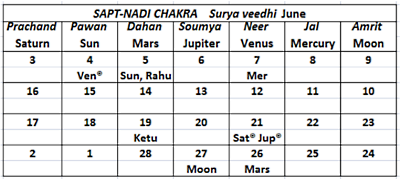
At the time of sankranti, position of Moon in Uttar Bhadrapad puts it in Varun mandal which promote rain. Moon in watery rashi anyways is good for rains. Also, it is in Hemduar indicating beneficent and plentiful rains. At the same time we can see that the other planets are not supporting.
(To be continued)
|
1. APPRAISAL OF MUNDANE PREDICTIONS - 2 (840073)
|
|
2. SUCCESS AND 11TH HOUSE - 1 (300422)
|
|
3. PREDICITING SECOND MARRIAGE (270480)
|
|
4. NO NEWS CAN BE GOOD NEWS (235074)
|
|
5. WILL SATURN SCORE A HATTRICK IN OCTOBER 2007 ? (208730)
|
|
6. AN INSIGHT INTO DREAMS (208302)
|
|
7. BENAZIR BHUTTO: A TRAGIC PREDICTION COMES TRUE (202032)
|
|
8. SHE OR HE ? HILLARY OR OBAMA ? (Revised) (193550)
|
|
9. DREADFUL YEAR 2007 (192522)
|
|
10. THE CASE OF SANJAY DUTT AND PUNISHMENT (186470)
|



